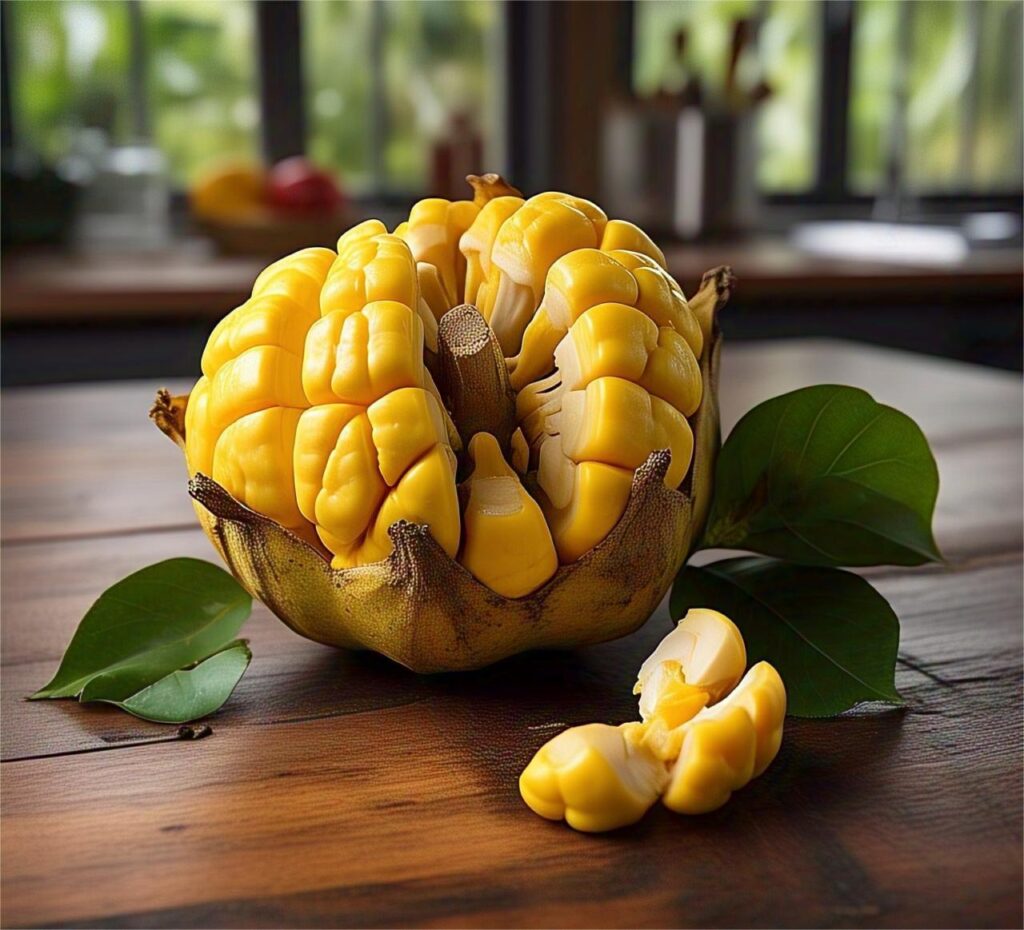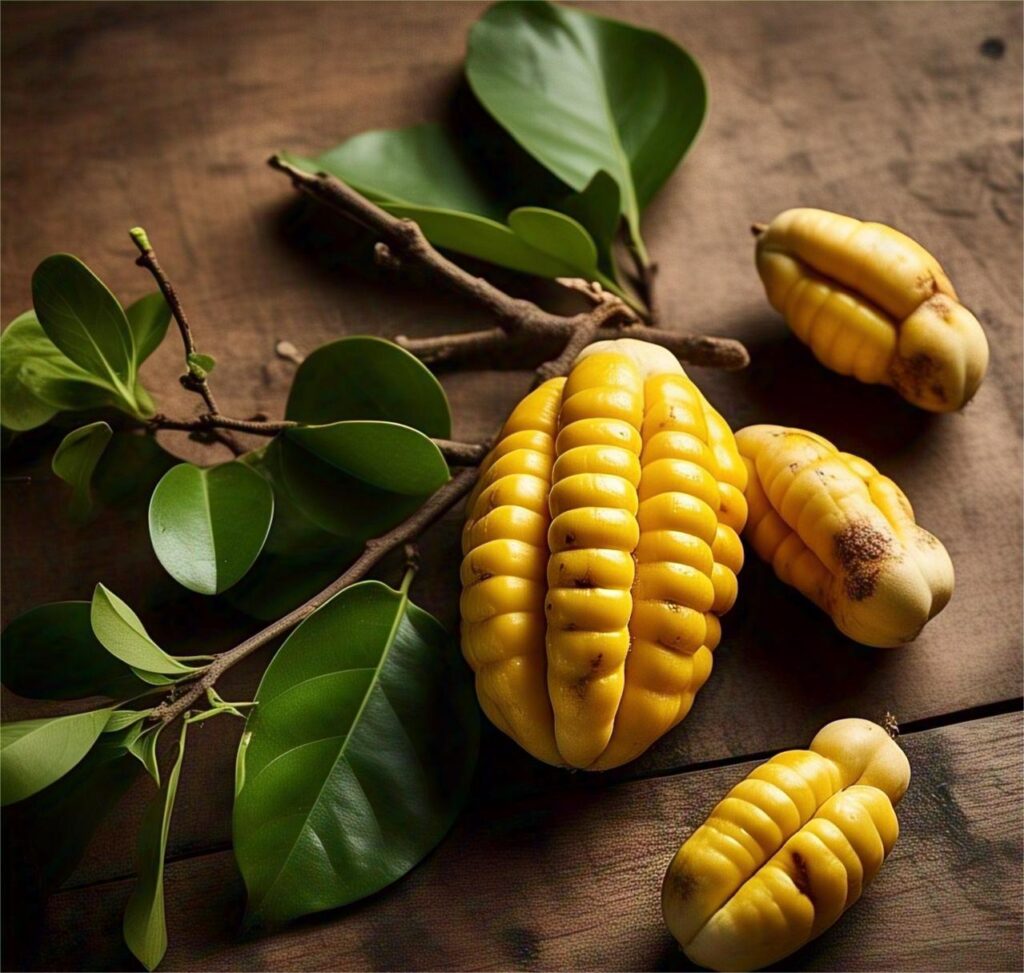
Introduction: The National Fruit with a Fascinating Story
Tropical fruits are known for their vibrant flavors, exotic origins, and cultural significance. Among them, the ackee fruit stands out—not just for its creamy texture and nutty flavor, but also for its unique status as both a delicacy and a potential danger. Native to West Africa and now an iconic part of Jamaican cuisine, ackee (Blighia sapida) has a rich history, nutritional value, and cultural legacy that make it a fruit worth understanding.
1. The Origins of Ackee: From Africa to the Caribbean
1.1 Native Roots in West Africa
Ackee originated in West Africa, where it grew wild and was used both as a food and medicinal plant. It gets its scientific name, Blighia sapida, from Captain William Bligh, the same infamous figure involved in the Mutiny on the Bounty. Bligh is credited with bringing the ackee fruit to Jamaica in the late 18th century.
1.2 A Jamaican Treasure
In Jamaica, ackee took on a new life. It adapted well to the tropical climate and quickly became an agricultural staple. Today, ackee is so cherished in Jamaica that it is the national fruit and the main component in the national dish: ackee and saltfish.
2. What is Ackee? A Look at Its Botany and Appearance
2.1 The Tree and Fruit
The ackee tree is evergreen, growing up to 10 meters tall. Its fruit is pear-shaped, green when unripe and turns red to orange when ripe. It splits open naturally when mature, revealing three large shiny black seeds surrounded by soft, cream-colored arils—the only edible part of the fruit.
2.2 A Fruit That Opens on Its Own
One of the unique traits of ackee is that it must open naturally on the tree before harvesting. This is a critical safety step because the fruit contains toxic compounds when unripe.
3. The Toxic Truth: Hypoglycin and Ackee Poisoning
3.1 What Makes Ackee Dangerous?
Unripe ackee contains a toxin called hypoglycin A, primarily found in the seeds and the unripe arils. If consumed before the fruit opens naturally, these toxins can lead to a serious condition called Jamaican Vomiting Sickness—a potentially fatal illness characterized by vomiting, hypoglycemia, and seizures.
3.2 How to Eat Ackee Safely
Only the fully ripened arils—after the fruit has naturally opened—should be eaten. They must also be thoroughly cleaned and boiled before consumption. This destroys residual toxins and makes the fruit safe to eat.

4. Culinary Uses: Ackee in the Kitchen
4.1 Ackee and Saltfish: Jamaica’s National Dish
The most famous preparation of ackee is the beloved ackee and saltfish. It’s made by sautéing boiled ackee, salted codfish, onions, tomatoes, and peppers in oil. The ackee’s texture is often compared to scrambled eggs, and its mild flavor pairs beautifully with the salty cod.
4.2 Other Culinary Applications
While ackee and saltfish reigns supreme, ackee is also used in:
Vegetarian dishes as an egg substitute.
Patties and pies.
Ackee rice or stews.
In vegan cuisine, ackee is gaining popularity as a plant-based protein alternative due to its creamy texture and neutral taste.
5. Nutritional Value of Ackee
5.1 Packed with Nutrients
Ackee is rich in essential fatty acids, especially linoleic, stearic, and palmitic acids, which are beneficial for heart health. It also contains:
Vitamin A, Vitamin C, Zin C, Calcium, Potassium, Protein
5.2 A Good Source of Healthy Fats
Unusual for fruit, ackee is high in healthy fats, which make it quite filling and ideal for those seeking low-carb, high-fat meal options like keto-style diets.
6. Cultural Significance and Symbolism
6.1 A Symbol of Jamaican Identity
Ackee holds a special place in Jamaican culture, not just as a food but as a national symbol. Its inclusion in the national dish symbolizes the resourcefulness and creativity of Jamaican cooking, which often combines native ingredients with global influences.
6.2 Featured in Music and Literature
Ackee has also found its way into reggae music, poems, and even political speeches. Its culinary importance is often used as a metaphor for resilience, independence, and cultural pride.
7. Global Trade and Availability
7.1 Export Regulations
Due to its toxicity when unripe, many countries regulate the import and sale of ackee. In the United States, for example, ackee must be canned and prepared under strict FDA guidelines before it can be sold.
7.2 Canned Ackee
Canned ackee is available internationally, especially in specialty Caribbean or African stores. Though not quite the same as fresh, canned ackee retains much of its texture and taste and is safe to eat.
8. Growing Ackee: From Backyard Trees to Plantations
8.1 Suitable Climates
Ackee thrives in tropical and subtropical climates. It requires well-drained soil, full sun, and warm temperatures year-round. It is drought-resistant but sensitive to frost.
8.2 Home Gardening
In Caribbean countries, ackee trees are often found in home gardens, where families harvest their own fruit. Growing ackee requires patience, as it can take 3 to 5 years for a tree to bear fruit.
9. Myths, Misconceptions, and Cautions
9.1 The Myth of Always Being Dangerous
Many people mistakenly believe that ackee is always poisonous. In reality, it is safe when harvested and prepared properly. The key is knowledge and care.
9.2 Children and Pregnant Women
Due to the risk of toxin exposure from improper preparation, some experts advise that young children and pregnant women avoid ackee unless it’s commercially processed.
10. Final Thoughts: A Fruit Worth Celebrating (With Caution)
Ackee is a remarkable fruit—rich in culture, flavor, and history. It tells the story of migration, adaptation, and culinary innovation. While its toxic potential cannot be ignored, safe preparation and growing awareness have allowed ackee to thrive not only in Jamaican kitchens but around the world.
Whether you’re enjoying a hearty plate of ackee and saltfish or simply admiring the tree’s beauty, ackee is a vivid reminder that even the most complex things in life can be nourishing, rewarding, and worth the effort.

FAQs About Ackee Fruit
Q: Can you eat raw ackee?
A: No. Only fully ripe ackee that has naturally opened on the tree is safe to eat—and only after cooking.
Q: Where can I buy ackee?
A: Canned ackee is available at Caribbean or African grocery stores, and in some international food sections.
Q: What does ackee taste like?
A: It has a buttery, creamy texture with a nutty, mild flavor, often compared to scrambled eggs.
Q: Can I grow ackee at home?
A: Yes, if you live in a tropical or subtropical climate. It’s a long-term project but rewarding.